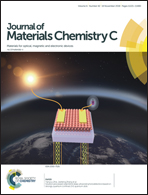Highly efficient non-doped OLEDs using aggregation-induced delayed fluorescence materials based on 10-phenyl-10H-phenothiazine 5,5-dioxide derivatives†
Abstract
A novel electron acceptor based on 10-phenyl-10H-phenothiazine 5,5-dioxide (2PTO) was introduced for the first time to construct aggregation-induced delayed fluorescence materials. The emitter PXZ2PTO contains phenoxazine as the electron donor, exhibiting both AIE characteristics and TADF properties. Due to the highly stereoscopic structure and small ΔEST of PXZ2PTO, a green non-doped TADF OLED realized a high maximum EQE, CE and PE of 16.4%, 44.9 cd A−1 and 32.0 lm W−1, respectively, without using any optical outcoupling technology, which is comparable with the best reported non-doped TADF OLEDs. In addition, the efficiency of the non-doped devices are comparable with that of doped PXZ2PTO devices, with the maximum EQE, CE and PE of 16.3%, 43.8 cd A−1 and 35.2 lm W−1, respectively.



 Please wait while we load your content...
Please wait while we load your content...